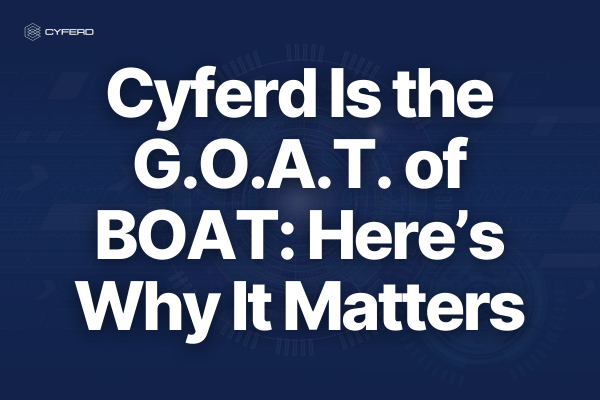Business

Cyferd Is the G.O.A.T. of BOAT: Here’s Why It Matters
How Business Orchestration and Automation Technology Sets a New Standard for Enterprise Transformation
You’ve tried RPA. You’ve wrestled with BPA. Maybe even dabbled in iPaaS to patch over clunky, disconnected systems.
These tools brought some improvements—but for most organizations, they delivered incremental gains rather than the sweeping transformation that digital initiatives often promise.
Now, Gartner has introduced a timely and much-needed framework: BOAT (Business Orchestration and Automation Technology). And this isn’t just another acronym to add to the list. BOAT represents a shift in mindset—one that moves beyond fragmented automation toward unified, intelligent orchestration.
While many vendors are now repositioning themselves to fit within this emerging category, one platform—Cyferd—already reflects many of BOAT’s core principles. Though BOAT is a newly defined term, Cyferd’s architecture has long aligned with the essence of what Gartner now outlines: end-to-end orchestration, composability, intelligence, and integration—all in one place.
Cyferd is a purpose-built business platform designed to simplify operations, unify data, and accelerate transformation—without the friction of fragmented tooling. With a single environment for building, integrating, and managing operational applications, Cyferd gives organizations the control and visibility they need to adapt quickly and operate intelligently.
In this post, we’ll explore the BOAT framework through Gartner’s recent research, unpack the market forces behind it, and explain why Cyferd is already well-positioned to help enterprises navigate this next phase of transformation.
What Is BOAT? Gartner’s New Class of Business Platforms
According to Gartner’s Quick Answer: Beyond RPA, BPA and Low Code — The Future Is BOAT, BOAT defines a new category of platforms built to transcend the limitations of today’s fragmented automation tools.
“BOAT platforms unify and automate end-to-end business processes, breaking down workflow silos and enabling seamless integration across various tools and technologies.”
—Gartner
Unlike traditional RPA or BPA—which automate isolated tasks or rigid workflows—BOAT platforms act as the central nervous system of the enterprise. They don’t just automate—they orchestrate end-to-end processes, unify data, and integrate applications and teams across departments.
It’s a monumental leap. Instead of building more bots, BOAT helps organizations steer the entire enterprise ship—coherently, intelligently, and adaptively.
Why BOAT—and Why Now? The Case for Unified Orchestration
In the push for digital transformation, organizations have in recent years adopted a range of automation and integration tools:
- Robotic Process Automation (RPA) to handle repetitive, rule-based tasks
- Business Process Automation (BPA) to structure and streamline specific workflows
- Integration Platform as a Service (iPaaS) to connect disparate cloud and on-premises systems
- Artificial Intelligence and Machine Learning (AI/ML) to support predictive insights and smarter decision-making
At first glance, this toolkit might seem like a recipe for efficiency. However, real-world results have too often fallen short. According to Gartner’s Do We Need Business Orchestration and Automation Technology (BOAT) Now?, the acceleration of automation efforts has often created new forms of operational complexity and fragmentation:
- Data trapped in organizational silos
- Workflows running in isolation, without true end-to-end visibility
- Duplicate automations emerging across business units
- Growing IT backlogs due to bespoke integrations and patchwork fixes
Gartner puts it succinctly:
“The market is shifting toward orchestration-first platforms (BOAT) that unify automation, eliminate redundancies, and put intelligence at the heart of business operations.”
Gartner’s research underscores that the coexistence of disconnected tools makes optimization harder, not easier. As businesses grow and evolve, fragmented automation stacks become a liability—slowing innovation and increasing risk.
The takeaway is clear:
Incremental tools can only take you so far. The next stage of transformation requires a platform that unifies automation, integration, and intelligence—so the entire enterprise can operate from a single, adaptive control layer.

The Six Pillars of a True BOAT Platform
Not every platform qualifies as a BOAT. According to Gartner’s analysis, true BOAT platforms share six defining characteristics:
- Unified Orchestration
Acts as the “brain” of operations—coordinating workflows across departments, systems, and data sources. - AI-Driven Automation
Uses AI/ML not just for insights, but to adapt, improve, and guide processes in real time. - Modularity and Scalability
Built to flex. BOAT platforms support composable, scalable, plug-and-play functionality. - Seamless Integration
Brings together cloud, on-prem, and legacy systems with robust connectors to deliver true end-to-end visibility. - Governance and Security
Delivers enterprise-grade compliance, security, and auditing—without slowing innovation. - Continuous Innovation
Enables organizations to adopt new technologies like GenAI, digital twins, or predictive analytics—without needing to reengineer core systems.
“BOAT isn’t just a consolidation of tools. It’s a new architectural paradigm—built around composability, adaptability, and intelligence.”
—Gartner
The BOAT Market: Gartner’s Forecast and What’s Driving Adoption
Shifting to BOAT isn’t trivial—but the opportunity is significant. According to Gartner’s Forecast Analysis: Business Orchestration and Automation Technology, Worldwide:
“Global spending on BOAT platforms will increase by 35% in 2025, reaching nearly $7 billion as organizations prioritize unified process automation and orchestration.”
Three major drivers are accelerating this shift:
- Rising cost of complexity: Fragmented systems waste time, money, and increase risk.
- Demand for agility: Businesses must evolve faster—whether it’s due to market shifts, regulations, or customer expectations.
- Digital expectations: Stakeholders—from employees to customers—expect seamless, intelligent digital experiences.
In other words, the ability to orchestrate operations at scale is no longer a luxury. It’s becoming a baseline requirement for digital competitiveness.
Cyferd: Naturally BOAT-Aligned—Before the Term Existed
While BOAT may be a new term in the market, its principles are not new to Cyferd. Cyferd’s architecture and capabilities align closely with the six BOAT pillars, making it a strong fit for organizations seeking unified orchestration, composability, and intelligent automation.
Here’s how Cyferd reflects the BOAT framework in practice:
1. Unified by Design
Cyferd brings together processes, data, and applications in one cohesive environment—avoiding the patchwork architecture that bogs down many enterprises. While not branded as a BOAT solution from inception, its core design mirrors the unified orchestration approach now outlined by Gartner.
2. Intelligence at the Core
Cyferd adapts to how your organization works—streamlining business processes and enabling efficient, informed decision-making. It aligns seamlessly with your operations, driving smarter outcomes exactly where they’re needed most.
3. AI That Powers Action
With Neural Genesis AI embedded in the platform, Cyferd helps organizations adapt in real time. It’s not just about insights—it’s about taking the right action when conditions change, without human micromanagement.
4. Built to Flex: Composability Without Compromise
Cyferd’s modular approach allows teams to respond quickly to new demands, regulatory shifts, or operational changes—without rewriting logic or starting over.
5. Integration Without Headaches
An API-first architecture allows Cyferd to connect with existing systems—legacy ERPs, SaaS tools, custom apps—past, present, or future.
6. Innovation on Your Terms
Cyferd enables continuous improvement—supporting the safe and steady evolution of digital capabilities as the business grows.
The Cyferd Advantage: Quietly Ahead of the Curve
While many vendors are now beginning to reshape their offerings around the principles of BOAT, Cyferd has been addressing these same challenges from the outset. Its platform was developed to reduce complexity, connect systems, and enable adaptive, enterprise-wide transformation—long before BOAT emerged as a formal category.
For organizations seeking a more intelligent and unified approach to digital operations, Cyferd provides a clear path forward:
- Simplify complexity with a single orchestration-ready platform
- Advance transformation without introducing additional tool sprawl
- Scale operations while maintaining oversight and security
- Strengthen resilience by reducing silos and avoiding technical debt
Without chasing labels, Cyferd has consistently aligned with the architectural thinking now gaining industry recognition.
Don’t Miss the BOAT—Book a Demo
The next wave of digital leaders won’t be the ones who automate the most—they’ll be the ones who orchestrate the best.
Book a demo today and explore how Cyferd can help you turn complexity into competitive advantage.
References: Key Gartner Resources for Deeper Insight
- Gartner: Forecast Analysis: Business Orchestration and Automation Technology, Worldwide
- Gartner: Do We Need Business Orchestration and Automation Technology (BOAT) Now?
- Gartner Webinar: The Future of Business Orchestration and Automation—Beyond RPA, BPA, Low Code
- Gartner: Quick Answer: Beyond RPA, BPA and Low Code — The Future Is BOAT
Find out more About Cyferd
New York
Americas Tower
1177 6th Avenue
5th Floor
New York
NY 10036
London
2nd Floor,
Berkeley Square House,
Berkeley Square,
London W1J 6BD
